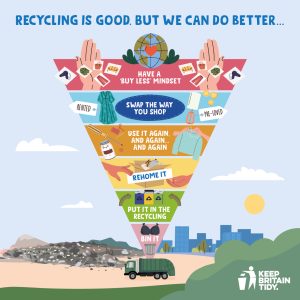Halloween waste
September 19, 2024

Halloween is fast approaching. Soon, you’ll see many shops filled with ghoulish decorations and children picking out costumes and pumpkins for the big day. The scariest part of this age-old festivity is not the creepy horror films or the eerie night sky. It’s the piles of horrifying waste piled into bins. Following the keep Britain Tidy Waste Hierarchy, the best thing to do is avoid buying things that will generate waste so you might want to try some of these hacks to keep your waste down.

The Keep Britain Tidy Waste Hierarchy
Much like Christmas, Halloween can create a pile of waste for one day of festivities. Thankfully, there are ways to have a low or zero-waste Halloween. Read on to discover five steps for having a more environmentally friendly Halloween at home and beyond: as with all things, it pays to be prepared.
Reuse your costumes
Seven million Halloween costumes are thrown away yearly, equating to 2,000 tonnes of plastic waste. Millions of families dress up for Halloween, often choosing outfits made from materials that aren’t hard-wearing and can’t easily be re purposed or recycled. Once worn, they are often sent for disposal.
Try for yourself or even encourage your friends and family to get creative and make costumes. Sourcing everything from your own wardrobe creates no waste and saves you money! Alternatively, buy a second-hand costume or you could hire one from a costume shop.
Whatever you do, keep the old costumes in use – donate them to a charity shop or drop them into a textiles bin if you cant reuse them yourself.
Eat your pumpkin
When you think of Halloween, you often think of pumpkins. Carved pumpkins are usually kept outside ‘to ward off evil spirits’. Over Halloween, it is estimated that over 39.9 million pumpkins will be on the streets, and nearly 22 million of these will go uneaten. That’s equivalent to £32 million worth of edible food going to waste each Halloween.
If pumpkins or other fresh fruit and veg go to landfill, they release methane gas. This is one of the greenhouse gases that contributes to climate change. To avoid this, try to eat your pumpkin before it goes rotten (usually within five days post-carving). Instead of carving your pumpkin you could decorate it instead, it so it’s fresh for when you are ready to eat it.
Use the flesh for pumpkin soup, roast it with other veg, or make a pie or cake. All pumpkin varieties are edible, although some are tastier than others. Smaller ones are usually better for eating and will also reduce your waste from anything you can’t eat or use. You can also save the seeds to grow your own pumpkins for next year or incorporate them into a recipe. |Hubbub offer a free pumpkin recipe book full of inspiration and guidance. For further tips why not look at| Hubbub How to Eat your Pumpkins
You can also home compost any parts of your pumpkin that don’t get eaten. You’ll find more information on our Home Composting pages.
If you can’t compost your pumpkin yourself, someone else might be able to do it for you. We will be running a “Pumpkin smash” / community composting event with one of our volunteer Master Composters in early November. Keep an eye on our upcoming events page for more information on how to donate your unwanted pumpkin and participate.
Please remember that shop bought pumpkins should not go into a garden waste collection.
Halloween decorations
If you’re a Halloween lover, you’ve probably planned on decorating your house. The best first step is checking what you have in storage from previous spooky events: can you use any of them again? However, some of these decorations like spooky skeletons, inflatable tombs and cobwebs are often single use and can find themselves in the bin at the start of November. Low-waste Halloween décor is a good solution, although having fewer decorations that make a bigger impact may also be a good way to reduce your waste.
Consider using old fabric, clothes, cardboard and garden waste, like twigs or leaves, to create your own spooky decorations. Being mindful of what you will do with them after Halloween, recycling or composting them when you’re finished with them. If you don’t have these items, alternatives could be buying well-made ones that can reused for several years. Consider how you store your Halloween decorations and costumes if you hope to keep reusing them and remember to remove and store batteries from anything that’s likely to be in storage for long periods of time. This will prevent corrosion and will help to prolong the life of the battery and the item you are storing.
Give away low packaging Halloween treats
Halloween sweets may be a nice treat, but they can trick us into creating more waste. Sweet wrappers often can’t be recycled as they are often made from multiple materials, such as plastic or paper combined with aluminium. This means they can’t go into your recycling bin at home. However, some wrappers might be able to be recycled at a store, you can check that here with Recycle Now’s Recycling Locator
Otherwise try to buy your sweets in a format that can be refilled. You can reuse the container to fill with sweets for future use like Christmas or parties. If you have time, baking Halloween treats so trick-or-treaters receive a home-baked low waste option is always great. However, it is best to be mindful of allergies, cross contamination and ensuring food safety so please be careful when handing out treats of any kind.
Sort your Halloween Waste
Follow our tips above to reduce your Halloween waste and don’t forget to reuse, recycle and compost where you can!
Please remember that all batteries need to be kept separate from the other waste materials otherwise they can explode, cause fires and a range of other environmental issues. Batteries and items containing batteries should never be put into your recycling bin or your general waste bin. Instead recycle them at your nearest battery collection point. The place nearest to you can be found on the RecycleYourElectricals recycling locator website.
Have a very happy Halloween!










